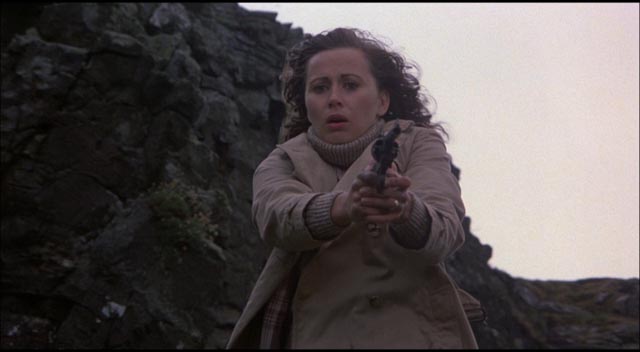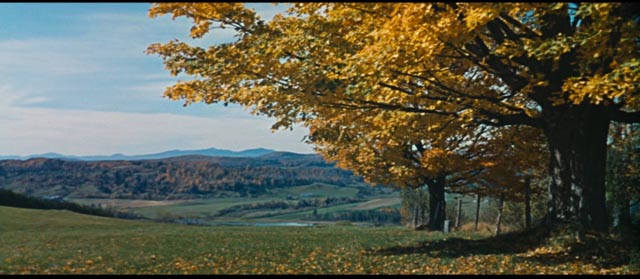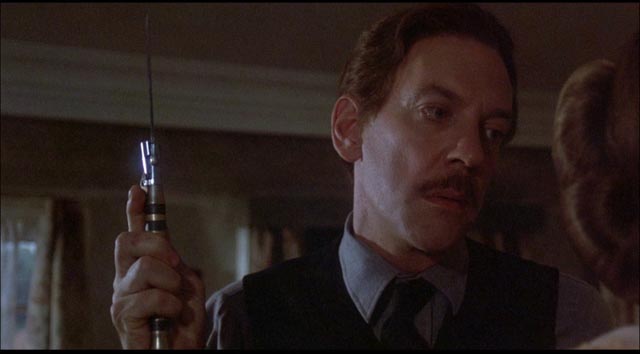Melodrama from Twilight Time

Let’s begin with a gross oversimplification.
Dramatically speaking, tragedy deals with the emotional and psychological storms endured by socially privileged people – kings and queens, princes and princesses, lords and ladies – who have the time and means to put all their energies into their personal problems. If Hamlet had to get up early and go do a full day’s work, day in day out, week after week, he would be much less likely to work himself into a moody depression which ends up triggering numerous deaths around him.
Melodrama, on the other hand, typically involves “ordinary” people – members of the lower and middle classes – who also have to deal with emotional and psychological issues, but are faced with the everyday necessity of making a living. That is, melodrama essentially brings tragedy down to our level, heating it up and stripping away the lofty pretensions. For this act of lowering, melodrama is often viewed as trashy entertainment rather than (high) art. And yet, a well-wrought melodrama can be a very effective vehicle for exposing the faults and hypocrisies of life as we live it in the context of our own society. In tragedy we see great themes and human experiences distilled and raised to a symbolic status which allows us to observe from a distance; in melodrama, we remain in the mire of everyday life.

In the Golden Age, from the ’30s through the ’50s, Hollywood studios excelled at melodramas. Some directors specialized in the form, like John Stahl (Imitation of Life [1934], Magnificent Obsession [1935], When Tomorrow Comes [1939], Leave Her to Heaven [1945]) and, particularly, Douglas Sirk (remakes of Magnificent Obsession [1954] and Imitation of Life [1959], and a string of masterpieces including There’s Always Tomorrow [1955], All That Heaven Allows [also 1955] and Written on the Wind [1956]), while others dipped in during long and varied careers – like Hitchcock with Rebecca (1940) and Suspicion (1941) and Michael Curtiz with Mildred Pierce (1945).
This list suggests one more reason why melodramas are looked down on. They are frequently woman-centred, and even when men are the focus, they are typically “feminized” through neurosis. This contrasts with the overwhelming predominance of men in prestigious tragedies. And as television displaced the movies as the entertainment of choice in the ’50s and ’60s, melodrama became even more tightly targeted towards women in daytime (and later, evening) soap operas, a genre which provided housewives and stay-at-home Moms with an exaggeratedly fraught fantasy version of their own lives. One of the first and most successful of the evening soaps was Peyton Place (1964-69), about which I have only vague memories; this chronicle of the seedy doings of supposedly respectable people in a small town formed the impression I’ve had for decades of the source novel by Grace Metalious as a trashy potboiler. It’s also why I’ve never made any effort to seek out the original movie version of the book – at least until now.

Peyton Place (Mark Robson, 1957)
Twilight Time recently released Peyton Place (1957) on Blu-ray and I decided to order it because I’d enjoyed director Mark Robson’s other famous trashy potboiler Valley of the Dolls (1967) when Criterion released it in 2016. The most surprising thing about Robson’s Peyton Place (made just a year after the novel was published) is that it is neither trashy nor a potboiler. While Robson was no stylist, the movie is worthy to stand alongside the work of Sirk in its dissection of middle class hypocrisy as a mechanism which not only enforces conformity but more specifically tries to contain and control female identity and sexuality. The film follows three women as they fight to assert themselves against that repressive small town society.
Although the central conflict is between Constance Mackenzie (Lana Turner) and her daughter Allison (Diane Varsi), the narrative is shaped by the experience of Selena Cross (Hope Lange), Allison’s best friend whose family comes from the wrong side of the tracks. Raped and impregnated by her alcoholic stepfather Lucas (Arthur Kennedy), Selena undergoes an abortion and later kills Lucas. Events build towards her trial, during which the town splits open at the seams and, in his big speech from the witness stand, Dr. Swain (Lloyd Nolan) turns the charges against Selena back on the good people of Peyton Place, whose meanness and hypocrisy helped to create the situation in which she was trapped.


That hypocrisy is also at the root of Constance’s antipathy to sex in any form, an attitude which alienates her daughter and pushes away Michael Rossi (Lee Philips), the new high school principal who pursues her romantically. Selena’s situation forces many secrets into the light with the promise of damaged lives healing. But this potentially happy ending can’t erase the sordid truths which have been unearthed during the previous two-and-a-half hours.
Given all the Production Code-stressing elements of the story – rape, abortion, murder, unmarried sex, illegitimate birth (incest is avoided only because Lucas is Selena’s stepfather) – it’s interesting to learn from the commentary by filmmaker Willard Carroll that the screenplay by John Michael Hayes (who scripted four of Hitchcock’s mid-’50s movies) tones down Metalious’ story. But as it stands, Peyton Place is an excellent example of the way Hollywood, even in the repressed ’50s, could balance salacious material with conventional morality in such a way that, even when social norms are apparently restored at the end, what lingers is the revelation of the seedy underside of a complacent and self-righteous middle class.
Twilight Time’s Blu-ray presents a colourful transfer which is particularly effective for the autumnal New England landscapes. In addition to Willard Carroll’s commentary, there’s a second track with actors Terry Moore and Russ Tamblyn, a featurette on the film’s locations narrated by Carroll, a Hollywood Backstory episode on the film, a couple of brief Fox Movietone newsreels and a trailer.
*

Eye of the Needle (Richard Marquand, 1981)
Another recent Twilight Time release takes a story of World War Two espionage and transforms it into a melodrama about a crippled marriage and a woman’s struggle to maintain a role which is gradually squeezing the life out of her. Richard Marquand’s Eye of the Needle (1981), based on the novel by Ken Follett, is a lush treatment of romantic disillusionment which hearkens back to an earlier age, its style as well as its narrative content recalling the ’40s, even as it infuses its story with a franker and more graphic depiction of sexuality. In this aim, it is greatly aided by one of the last scores written by Miklós Rózsa, a specialist in richly romantic orchestral compositions.
The film is also aided by some exceptional, fully-committed performances – particularly Kate Nelligan, who provides the film’s emotional centre, a heart-breaking combination of longing, vulnerability, strength and independence. While Nelligan is ably supported by Donald Sutherland and Christopher Cazenove, this is very definitely her story.

Eye of the Needle opens with a double prologue. A boarding house owner in London inadvertently walks in on one of her tenants and discovers him using a shortwave radio. This man is Faber (Sutherland), a German spy whose English education enables him to pass undetected as the Battle of Britain begins. He kills the landlady and goes to ground.
Meanwhile, Lucy (Nelligan) is being married to dashing RAF pilot David (Cazenove) at an opulent middle class wedding. As they head off on their honeymoon in his open sports car, his youthful carelessness and arrogance lead to catastrophe; speeding along a narrow country lane, drinking champagne, he loses control and the car crashes.
Four years later, we find Lucy and David living on a small rocky island off the coast of Scotland. They have a young son, Joe (twins Jonathan and Nicholas Haley), apparently conceived before the wedding. David is a paraplegic, confined to a wheelchair and well on his way to alcoholism. With his career as an ace fighter pilot cut off at a crucial moment in the war, he is bitter and resentful. Despite the crash being his own fault, he directs his anger at Lucy, pointedly rejecting any attempt at physical contact.

Down south, Faber acquires crucial information in the days leading to D-Day. He discovers that the massed materiel and planes on the southeast coast across from Calais are dummies, mere plywood shells intended to dupe aerial reconnaissance and get the Germans to concentrate their defences around Calais instead of in Normandy. On the run from British counterintelligence, Faber heads north towards a rendezvous with a U-Boat with only days to spare. Caught in a storm, the stolen fishing boat he’s piloting is wrecked on a rocky shore and he drags himself clear of the waves. Exhausted, he manages to reach a remote farmhouse … where, of course, Lucy lives with her family.
David sees Faber as a male, rather than national, threat. And yet he all-but pushes Lucy towards the interloper – perhaps feeling that his anger towards her will be justified if she stops being dutifully attentive and betrays him. Faber is adept at charm and, as he recovers from the battering he received in the storm, Lucy is drawn towards him and, frustrated with David’s physical rejection, she becomes the stranger’s lover while David spends more time drinking with the lighthouse keeper, Tom (Alex McCrindle). Treated poorly by David and artfully manipulated by Faber, Lucy initially struggles with her own conflicted emotional and sexual feelings; but as Faber’s U-Boat rendezvous draws closer and he has to become more violent to fulfill his mission, Lucy realizes just how she has been used and betrayed and she is forced to fight for her own and Joe’s survival.

Although the film cuts back and forth between events on the island and the gradual closing-in of British intelligence – led by Inspector Godliman (Ian Bannen), who has pieced together details of Faber’s identity and the crucial nature of the information he is trying to take back to Germany – Lucy is finally on her own. Her personal story, with her need to pay Faber back for his emotional betrayal, dovetails with the strategic story; acting as a woman asserting her own independence, she also manages to ensure the success of the invasion of Europe. This mixture of romance and espionage, by focusing so closely on Lucy’s emotional journey, effortlessly embodies that feminist dictum: here the personal is inextricably bound to the political.
Marquand, working from a script by Stanley Mann, does a fine job of evoking the story’s period – not by any kind of documentary realism, but rather by emulating the era’s cinematic forms. With the music of Rózsa, production design by Wilfred Shingleton (an old hand at period films) and lush photography by the eclectic Alan Hume, Eye of the Needle is a classic “women’s film” which allows its female protagonist to transcend the limitations (emotional, sexual and narrative) which the form traditionally imposed on women, by punishing them for their transgressions or, at best, recontaining their desires in socially acceptable ways.
The image on the Twilight Time Blu-ray has subdued colours appropriate to the damp Scottish location. In addition to the usual isolated score track, there’s a commentary with music historian Jon Burlingame joining Julie Kirgo and Nick Redman, plus the original trailer.
*
Also from Twilight Time
At a stretch you might also call a couple of older releases (both from 2014) melodramas … at least, there are melodramatic elements in Robert Wise’s Audrey Rose (1977) and John Schlesinger’s The Believers (1987), though both play more with the horror genre than the women’s film.

Audrey Rose (Robert Wise, 1977)
As you’d expect from an old pro like Robert Wise, Audrey Rose is competently crafted, with decent performances, but Frank DeFelitta’s New Age riff on The Exorcist isn’t exactly dramatically convincing. The well-off New York parents of a young girl are doubly troubled when their daughter Ivy (Susan Swift) begins having nightmares and sleepwalking just as they notice a strange man stalking them. He’s Elliott Hoover (a twitchy Anthony Hopkins), whose own daughter Audrey Rose died in a horrific car crash eleven years earlier and he’s now convinced (thanks to a couple of psychics) that Ivy is Audrey Rose reincarnated. The girl’s nightmares are driven by memories of her death. The problem, apparently, is that she didn’t have time to adjust after dying, but was instantly reborn as Ivy … in effect, Ivy is possessed by the soul of Audrey Rose.
Ivy’s dad, Bill Templeton (John Beck), is a skeptic, but her mom Janice (Marsha Mason), driven by her desperate need to alleviate her child’s pain, is gradually brought around to believing Elliott. Things reach a crisis and Elliott ends up on trial. Rather implausibly, the court case turns into a lecture on reincarnation and Janice finally testifies that she’s convinced that Ivy really is Audrey Rose. At which point the judge orders a test in which a psychiatrist regresses the girl to her previous life, essentially sending her back to the horror of being burned to death. This doesn’t end well, but we’re told that Audrey Rose/Ivy’s soul is now free to adjust and prepare properly for her next incarnation.
Wise and his cast strain to keep this all from sinking into risible nonsense, but they’re not entirely successful. In the midst of all the plot contrivances, Marsha Mason gives an incredibly moist performance, spending almost the entire running time on the brink of tears. Even in the Golden Age of the women’s film, few actresses would have risked such a weepy performance.

The Believers (John Schlesinger, 1987)
The Believers, John Schlesinger’s odd foray into horror, begins with the elimination of a happy family’s mother in what may be the most bizarre opening scene in Hollywood history. It’s breakfast time and Lisa Jamison (Janet-Laine Green) is doing that mom thing of juggling multiple tasks while dad Cal (Martin Sheen) takes a shower and son Chris (Harley Cross) sits at the kitchen table. Milk is spilt on the floor and the plug of the toaster begins to short out. Poor Lisa is barefoot, providing a perfect ground when she tries to unplug the toaster … and husband and son get to watch helplessly as she’s electrocuted in a scene so protracted that its absurdity can’t be avoided.
From this point on, Cal is the focus: a single parent tormented by grief and guilt while juggling his career with a sense of inadequacy about his responsibility for Chris’s safety and well-being. Dad moves with his son to another city (New York), where he takes up work as a police psychologist just as a series of brutal child murders begin. The script by a pre-Twin Peaks Mark Frost (based on a novel by Richard Conde) takes the well-worn pulp path of transforming Santeria, a syncretic religion practiced by Caribbean descendants of African slaves, into a monstrous supernatural cult akin to the movies’ treatment of voodoo. Despite the distortions inflicted on an actual religious practice (which combines traditional Yoruba beliefs with Catholicism), the story does take an interesting direction as it becomes apparent that the wealthy 1% have appropriated Santeria’s supernatural potential to consolidate and expand their wealth and power … the price of admission being the sacrifice of one’s own child to the gods.

There are vague echoes of Rosemary’s Baby and The Stepford Wives, with the addition of some graphic gore, but Schlesinger is ill-suited to the genre and the movie never really embraces its pulpy essence, strangely trying to maintain an air of class and respectability. This is largely done through Robby Müller’s polished cinematography and a cast headed by such stalwarts as Sheen, Helen Shaver, Jimmy Smits, Harris Yulin and Robert Loggia. The Believers is one of those movies where just about everyone turns out to be in on the conspiracy, but by the late ’80s its cynical ending (evil lives on) feels not just perfunctory, but totally arbitrary, a lazy nod to the paranoid thrillers of the previous decade.
Neither of these movies apparently warranted any additional effort from the folks at Twilight Time, as the only extras are trailers and the usual isolated score tracks.
*

You couldn’t get much farther from these movies than Twilight Time’s double feature of Burt Kennedy’s Support Your Local Sheriff! (1969) and Support Your Local Gunfighter (1971), a pair of western comedies built around James Garner’s natural charm (the actor was an executive producer on both). These light and witty movies (the first scripted by William Bowers, the second by James Edward Grant) were obviously the models for Garner’s short-lived TV series Nichols (1971-72). In the first, Garner is a drifter on his way to Australia who is roped into being sheriff of an anarchic mining town, using his wits to bring order to the unruly population. In the second, he’s a con man who is mistaken for a famous gunfighter and uses the misunderstanding for his own benefit.
Kennedy seizes the opportunity to affectionately mock the genre in which he had been making his living since writing a string of great Budd Boetticher movies in the mid-’50s; each film is packed with familiar supporting players, which gives them a comfortably populated feel.
The disk features colourful transfers, isolated score tracks and trailers, plus a commentary on Sheriff! by film historians Lee Pfeiffer and Paul Scrabo.
Comments
I enjoyed the James Gardner films when I saw them as a young lad and again about 10 years ago. I am sort of excited to get a loan of Nichols from the library. I watch them and see if I really need a copy for myself. I suspect not.
I’ve been rationing episodes of Nichols as there was only the one season (24 episodes). It has the same tone and charm as the two Support Your Local … movies.
I put it on my Amazon Wish List, maybe the price will fall a few bucks and I’ll grab one.